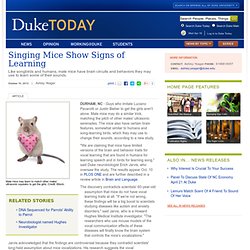

Mice can sing and learn new tunes. Singing mice show signs of learning. Guys who imitate Luciano Pavarotti or Justin Bieber to get the girls aren't alone.

Male mice may do a similar trick, matching the pitch of other males' ultrasonic serenades. Of Mice, Birds, and Men: The Mouse Ultrasonic Song System Has Some Features Similar to Humans and Song-Learning Birds. Humans and song-learning birds communicate acoustically using learned vocalizations.

The characteristic features of this social communication behavior include vocal control by forebrain motor areas, a direct cortical projection to brainstem vocal motor neurons, and dependence on auditory feedback to develop and maintain learned vocalizations. These features have so far not been found in closely related primate and avian species that do not learn vocalizations. Singing Mice Show Signs of Learning. Durham, NC - Guys who imitate Luciano Pavarotti or Justin Bieber to get the girls aren't alone.

Male mice may do a similar trick, matching the pitch of other males' ultrasonic serenades. Institute for Brain Sciences - Jarvis, Erich - Ph.D. Associate Professor; Howard Hughes Medical Institute Investigator Neurobiology, School of Medicine DIBS Faculty Research Description Our goal is to understanding the molecular mechanisms that construct, modify, and maintain neural circuits for vocal learning.

Vocal learning is the ability to modify or imitate the acoustic structure and sequence of vocalizations and is a critical behavioral substrate for spoken language. Scientist Abstract: Erich D. Jarvis, Ph.D. Singing Mice Can Change Their Tune. The newest singing sensation in the animal kingdom?

Mice. The creatures not only sing ultrasonic melodies high above sopranos, distinct from their regular squeaks, but they also learn new tunes from each other, researchers report today (Oct. 10). Song learning is known to exist in humans, dolphins, songbirds and parrots, but the new research overthrows a 50-year assumption that mouse vocalizing is inborn and instead shows that mice have a rudimentary vocal system to control their vocal cords and learn new tunes. "The mouse brain and behavior for vocal communication is not as primitive and as innate as myself and many other scientists have considered it to be," senior author Erich Jarvis, a neurobiologist at Duke University, told LiveScience.
"Mice have more similarities in their vocal communication with humans than other species like our closest relatives," Jarvis added, referring to chimpanzees. Singing new songs What's next. House Mice Serenade Mates with 'Bird' Song. Most people are familiar with the telltale squeak of a mouse scurrying out of their pantry, but scientists have long known that these aren’t the only noises house mice make.

During courtship, the rodents also communicate in the ultrasonic frequency range, which sits beyond human hearing. Now, new research shows that these mating vocalizations are more than just your typical squeaks — they’re songs, not unlike those you’d expect to hear from courting birds. “It seems as though house mice might provide a new model organism for the study of song in animals," lead researcher Dustin Penn, an evolutionary biologist at the Veterinary University of Vienna in Austria, said in a statement. "Who would have thought that? " Over the last few years, Penn and his colleagues conducted a series of studies on the courtship vocalizations of house mice.
They found that most of the male mice would start their ultrasonic callsthe moment they caught the urine scent of a sexually mature female. Mice can sing and even change tune like humans. Like guys who imitate Luciano Pavarotti or Justin Bieber to get the girls, male mice may also match the pitch of other males' ultrasonic serenades.

A new study has revealed that mice also have certain brain features, somewhat similar to humans and song-learning birds, which they may use to change their sounds. "We are claiming that mice have limited versions of the brain and behaviour traits for vocal learning that are found in humans for learning speech and in birds for learning song," said Duke neurobiologist Erich Jarvis, who oversaw the study. Like songbirds and people, mice can learn new tunes. Public release date: 10-Oct-2012 [ Print | E-mail Share ] [ Close Window ] Contact: Jyoti Madhusoodananjmadhusoodanan@plos.org 415-568-4545 x187Public Library of Science Scientists have found the first evidence that the ability to learn vocalizations, a capacity so far believed to be restricted to a handful of bird and mammal species like humans and dolphins, is shared by another species: mice.

The new research, published Oct. 10 in the open access journal PLOS ONE by Erich Jarvis and Gustavo Arriaga at Duke University and colleagues, shows for the first time that mice share certain behavioral and brain mechanisms involved in vocal learning with songbirds and humans and can learn new vocal patterns. Most animals make sounds of some sort, but only a few have the capacity to modify the sequence and pitch of sounds to create songs and speech, collectively referred to as vocal learning. Competing Interest Statement: The authors have declared that no competing interests exist. [ Print | E-mail. The Mystery of the Singing Mice.